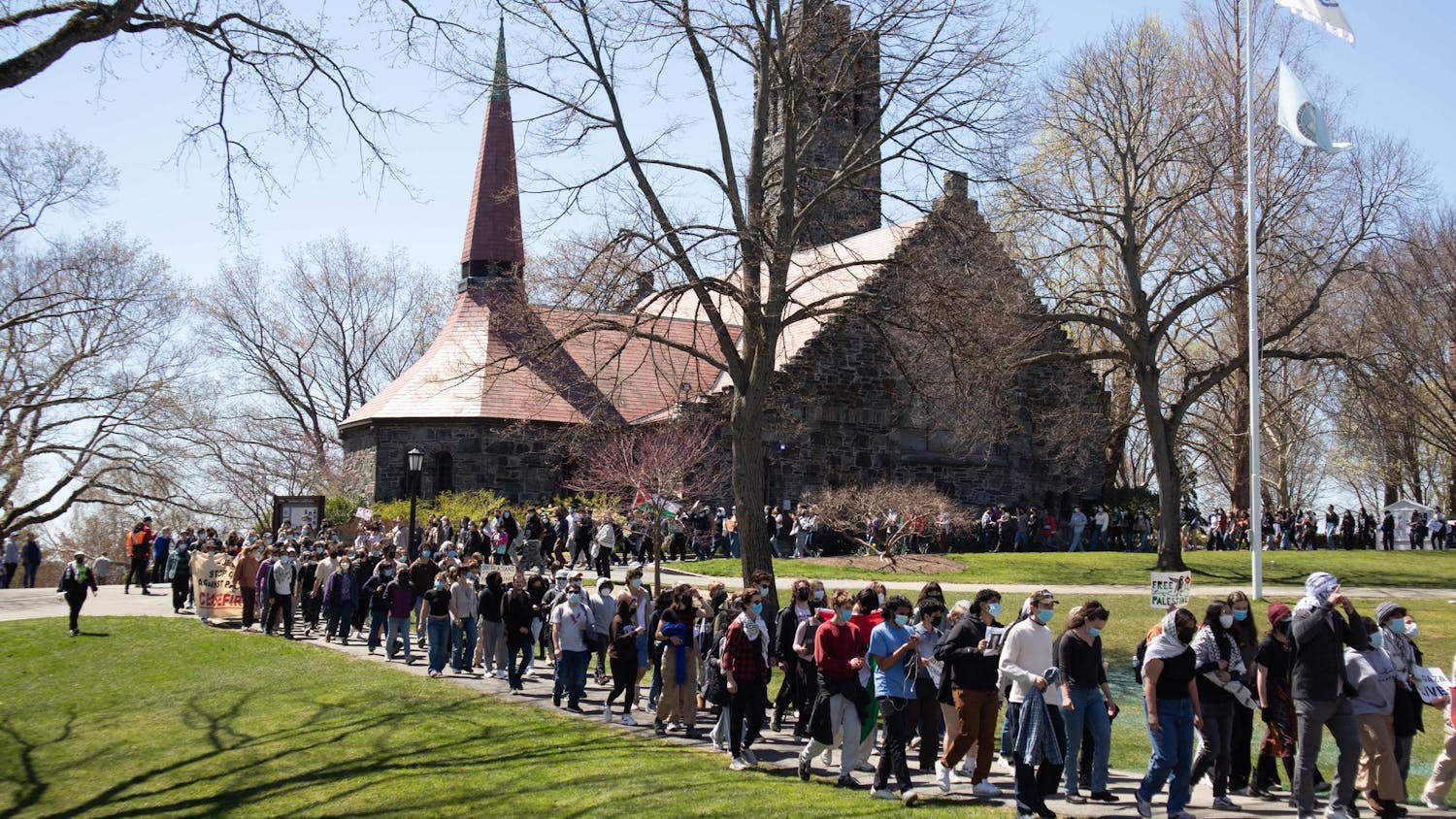On the morning of Nov. 17, Medford City Solicitor Mark Rumley, acting at the behest of Medford Mayor Stephanie Burke, requested that Skinner Auctioneers and Appraisers remove seven Native American artifacts owned by the Medford Public Library (MPL) from a Dec. 1 auction, according to Rumley.
The seven artifacts from the northwest United States -- donated to the MPL in 1880 -- included a totem pole valued at $800 to $1,200 and two shaman’s masks both valued at more than $30,000, according to figures since removed from Skinner's website, but cited in a Nov. 17 Boston Herald article that first reported this issue.
A public notice was released on Nov. 13 by Shab Khan, Medford's chief budget and procurement officer, announcing the auction.
According to MPL Director Barbara Kerr, the library deemed the objects as “surplus goods” at a meeting of the library's Board of Trustees in the spring, and the auction proceeds were intended to fund the construction of the new public library.
“I was concerned about what would happen to [the artifacts] while [the library was] moving,” Kerr said. “We thought that putting them into the auction would be the best solution because it would get them into the hands of someone who could care for them properly.”
Concerns about the auction centered on the fact that the sale may have violated the 1990 Native American Grave Protection and Repatriation Act (NAGPRA), according to the Boston Herald article.
Shannon Keller O’Loughlin, executive director of the Association on American Indian Affairs, said that NAGPRA requires federally-funded organizations that possess Native American sacred objects or cultural patrimony to inventory these items and begin to work to repatriate these items to their respective tribes. She added that the sale of these items is considered illegal trafficking and can result in criminal penalties.
O’Loughlin, a member of the Choctaw Nation, said that MPL’s failure to inventory the objects with the federal government and the proposed sale were both illegal.
Rumley said that he contacted Michael Evans, director of American Indian and ethnographic art at Skinner, on the evening of Nov. 14 about the Boston Herald’s inquires, and formally requested the withdrawal of the artifacts Nov. 17.
Burke issued a statement Nov. 19 announcing the move and Rumley issueda legal opinionfor the city Nov. 20 concluding that the artifacts were protected under NAGPRA.
“As soon as [Burke] became aware of the issue, she ordered that these objects be withheld and the law be examined, and that happened the very next morning,” Rumley said.
Burke said that the city is waiting for Skinner to return the artifacts and has already been contacted by parties volunteering to help the city repatriate the objects back to tribes pursuant to NAGPRA.
“Once it was brought to our attention, we take an oath to follow the law, and whether the law be local, state or federal, we will comply with it. That is what our oath was and that is how we will operate,” Burke said.
Skinner determined that the most expensive artifacts, the two shaman’s masks, came from the Tlingit people.
Desiree Duncan, manager of the native lands and resources department in the Central Council of the Tlingit and Haida Indian Tribes of Alaska, told the Daily in an email that the masks in question appeared to be Tlingit, and that the department will be submitting a NAGPRA claim for the objects after it is determined which categories the objects fall under.
Darren Lone Fight, a lecturer in American studies at Tufts and member of the Three Affiliated Tribes, said he was surprised when he learned of the attempted auction of the artifacts.
“This seemed like a pretty clear violation of federal law," Lone Fight said. "When I had read about it, I was surprised not only because it seemed to indicate an ignorance of federal policy regarding cultural artifacts of Native peoples but also that it seemed to be being sold just for short term profit.”
Kerr said the MPL had discovered the artifacts in the mid-1990s and had then stored them securely, but was unaware of its obligations under NAGPRA.
“That is something the auction house should have picked up. We trusted to their expertise with the legalities; we trusted that they’d read the fine print and do the research and they didn’t,” Kerr said. “If they had, we never would’ve gotten to the point of putting things in the auction because we would’ve [known] that we fell under NAGPRA.”
When Rumley asked Skinner if the objects were covered by NAGPRA and if the city was violating the law, he said Evans told him that the act is not applicable for libraries and for artifacts that were "crafted for sale."
However, Chip Colwell, senior curator of anthropology at the Denver Museum of Nature & Science, who has written extensively on NAGPRA, said that if the library receives any federal dollars, the act applies. Colwell also questioned Skinner’s claim that NAGPRA does not cover Native American artifacts that were “crafted for sale.”
“There’s nothing that I know of in the law that says that if an item is made for sale or turned into a commodity in any way, that it is not subject to the law,” he said.
Colwell said that the law’s original goal was to establish a process by which Native American artifacts -- many of which had been procured by theft, fraud or grave robbery -- would be returned to tribes.
“I’ve seen through my research that largely repatriation restores a sense of dignity to native community members. It allows them to embrace their humanity and their human rights to control their own heritage, and it can lead to spiritual healing, even physical healing,” Colwell said.
O’Loughlin said that Skinner has an ethical and professional obligation to provide due diligence to prevent this from happening.
“I look more down on Skinner ... for taking these items from a public institution. Medford has that legal responsibility but Skinner also has a responsibility not to sell stolen items, not to sell items that are obligated under law to be repatriated,” she said.
Skinner CEO Karen Keane declined to answer questions but provided the Daily with a statement from the auction house.
“Skinner Inc. recognizes and respects the importance of objects of material culture to the indigenous people who created them and whose heritage they represent. Skinner Inc. also respects and complies with [NAGPRA] and all federal laws governing the transfer of tangible property,” the statement read.
The artifacts in question were originally donated to the MPL by James G. Swan, a Medford resident who went to Washington state and became an U.S. Indian agent and ethnographer, according to Kerr.
“He has a very good reputation as somebody who bought stuff from the people who made them,” Kerr said.
Lone Fight said that Swan was one of the first collectors of artifacts for the Smithsonian Institution, learned the Chinook language and occasionally advocated for local tribes, but was someone who was "intemperate."
“It’s very difficult to say whether something sold under duress to an Indian agent who has a significant amount of power over the group of people can be sold in good faith,” Lone Fight said.
Mindy Nierenberg, senior director of programs at the Jonathan M. Tisch College of Civic Life and 15-year Medford resident, wrote a petition against the auction when she heard of the news on Facebook.
Nierenberg took students on eight trips to the Navajo Nation as part of a class she co-taught at the Massachusetts College of Art and Design, and said her Navajo friends still suffer from the effects of generations of discrimination.
“Although the artifacts in Medford are not Navajo, the issues are the same in their unjust 'collecting' by profiteers and museums,” Nierenberg told the Daily in an email. “I think the City needs to reflect on how the original decision to have the auction was made so that poor decision-making processes are minimized in the future.”
Medford cancels auction of Native American artifacts, citing federal law

Shelves of books in the Medford Public Library are pictured on Dec. 4.





